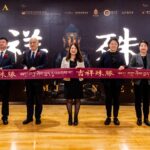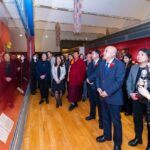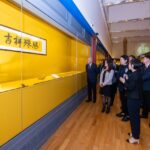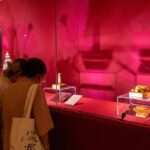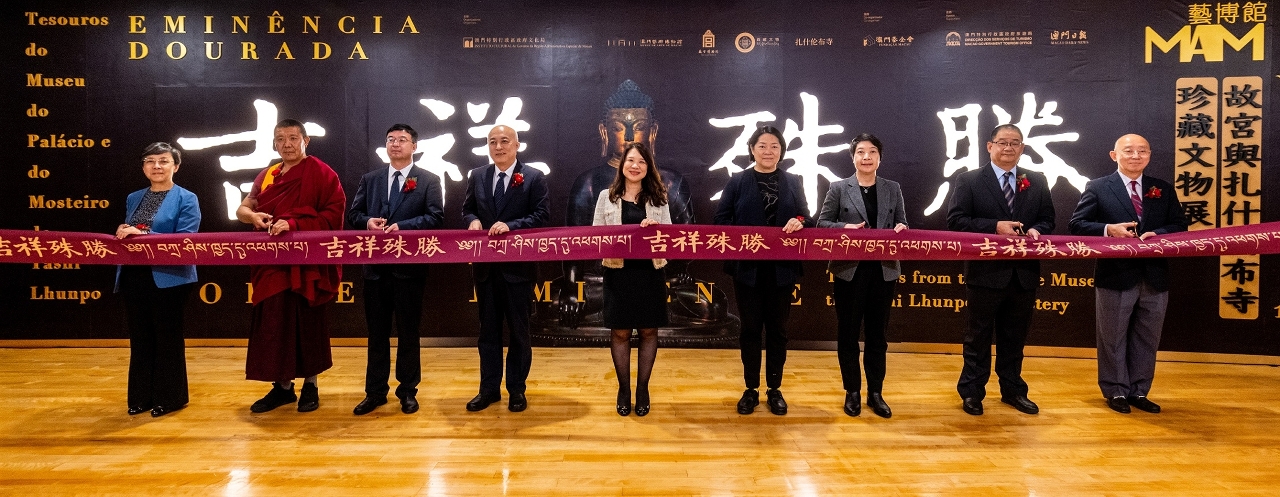 Group photo of the guests
Group photo of the guests
The exhibition “Golden Eminence: Treasures from the Palace Museum and the Tashi Lhunpo Monastery” was inaugurated at 6:30pm on 15 December, on the fourth floor of the Macao Museum of Art. The opening ceremony was officiated by the representative of the Secretary for Social Affairs and Culture of the Macao SAR Government and the Chief of Office of the Secretary for Social Affairs and Culture of the Macao SAR Government, Ho Ioc San; the Director of the Palace Museum, Wang Xudong; the Deputy Director of the Liaison Office of the Central People’s Government in the Macao SAR, Yan Zhichan; the Secretary of the Communist Party of the Tibet Autonomous Region Cultural Heritage Bureau, Zhao Xingbang; the President of the Cultural Affairs Bureau, Leong Wai Man; the Deputy Director of the Management Committee of the Tashi Lhunpo Monastery, Luo Sang Zha Xi; the President of the Macao Foundation, Wu Zhiliang; the Director of the Macao Government Tourism Office, Maria Helena de Senna Fernandes; and the Director of Macao Daily News, Lok Po.
In this exhibition, 137 pieces of treasures were meticulously selected from the collections of the Palace Museum and the Tashi Lhunpo Monastery, which was divided into three sections, namely “From Tashi Lhunpo Monastery to the Palace Museum”, “Art from the Tashi Lhunpo Monastery” and “Treasures of the Sixth Panchen Lama”. The exhibition takes the public to explore the ancient history and appreciate the cultural richness and artistic legacy of Tibetan Buddhism accumulated over a long history, and discover the glorious history of unity, solidarity, interaction and harmony of the Chinese nation. The Tashi Lhunpo Monastery of Tibet and the Palace Museum is connected by Tibetan Buddhism. Among the exhibits, the cultural relics related to the Sixth Panchen Lama’s visit to Beijing to meet the Emperor Qianlong are the most eye-catching. Through the golden seal and golden book used in the appointment ceremony for Panchen Lama by the emperor, as well as the exchanges of cultural relics, Buddhist statues and imperial edicts between Emperor Qianlong and the Sixth Panchen Lama, the public can witness the close relationship between Tibet region and the central government, as well as the interaction between the two parties in terms of art and technology during the period of the Emperor Qianlong.
In addition, in order to bring art closer to everyday life, the exhibition features an interactive education zone. Exhibition brochures and audio tours via QR code are also available on-site. A series of intriguing outreach activities will be launched successively during the exhibition period, including “Music in MAM” by the Macao Chinese Orchestra at 3:30pm on 17 December, the “Singing Bowl Performance” at 5:30pm on 17 and 30 December and public guided tours in Cantonese in the afternoon on Saturdays, Sundays and public holidays from 20 December. Admission to the abovementioned activities is free and all are welcome to participate.
The exhibition is organised by the Macao Museum of Art under the Cultural Affairs Bureau, the Palace Museum, the Tibet Autonomous Region Cultural Heritage Bureau and the Tashi Lhunpo Monastery, and co-organised by the Macao Foundation, with the support from the Macao Government Tourism Office and the Macao Daily News. The exhibition is held until 17 March 2024. The Macao Museum of Art is open from 10am to 7pm (no admission after 6:30pm), including on public holidays, and is closed on Mondays. Admission is free. For more information about the exhibition and outreach activities, please visit the MAM’s official website at www.MAM.gov.mo.


